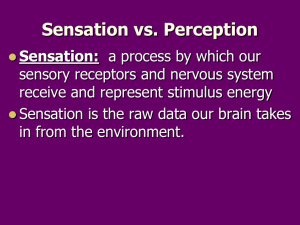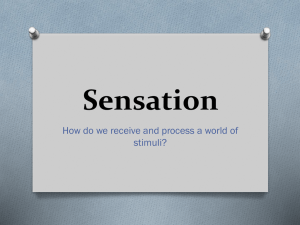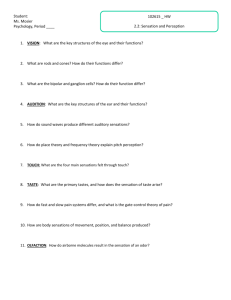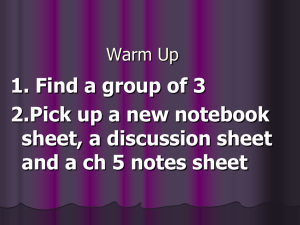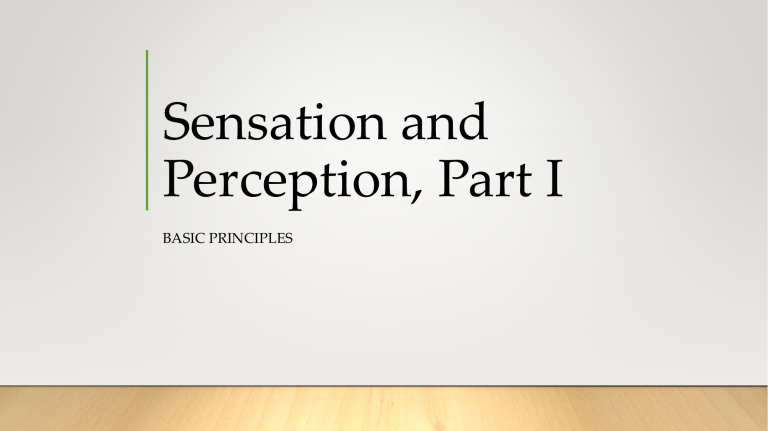
Sensation and Perception, Part I BASIC PRINCIPLES What are Sensation and Perception? • Sensation: Earliest contact between environment and nervous system • Sensation involves translating physical stimulus properties (light, sound, heat, pressure, chemical composition) into electrical impulses • Transduction: conversion of physical stimulus properties into neural impulses • Occurs within sensory organs (receptors) What are Sensation and Perception? • Perception: Further processing and interpretation of sensory information • Conscious experience of the world Sensation and Perception: Basic Principles • Need to signal quality and quantity of sensory experience • Quality: determined by which sensory system is stimulated (e.g., stimulation of receptors in the eye signals that light is present) • Quantity: signaled by the rate of neural impulses • More intense stimulus elicits higher rate of action potentials Sensation: Thresholds • Basic question: How sensitive are our sensory systems? • Absolute threshold: How intense does a stimulus need to be before you can just detect it? • Difference threshold: How much does the intensity of a stimulus need to change before the change is noticeable? Determining Absolute Threshold Ideal Data Typical Data 100 Percent Detection Percent Detection 100 80 60 40 80 60 40 20 20 0 0 1 2 3 4 5 6 Stimulus Intensity 7 8 1 2 3 4 5 6 Stimulus Intensity 7 8 50% Percent Detection 100 80 60 Absolute threshold: Stimulus intensity that can be detected 50% of the time. 40 20 0 1 2 3 4 5 6 Stimulus Intensity 7 8 Difference Threshold • Amount of change that can be detected is a percentage of the stimulus intensity • Example: can detect a 7.9% change in brightness • But a 1.3% change in shock intensity! Sensation and Perception: Basic Principles • Adaptation: sensory systems respond less over time to a constant stimulus • Can produce dramatic aftereffects Sensation and Perception, Part I THE EYE Vision: The Eye • Pupil: opens (dilates) and closes (contracts) to control amount of light entering eye • Iris: muscle that controls the pupil’s size Vision: The Eye • Cornea • Clear – lets light in • Curved – focuses light as it enters • Lens • Changes shape to bend light more or less (accommodation) • Adjustable focus Vision: The Eye • Retina • Photosensitive layer at the back of the eye • Contains receptors: rods and cones Rods and Cones Rods Cones • 120 million per eye • 6 million per eye • Very sensitive to light – work best in dark conditions • Not very sensitive to light – work best in light conditions • Not sensitive to color • Sensitive to color • Poor acuity • Good acuity The Fovea • Area of highest acuity on the retina • Contains only cones • Center of vision falls on the fovea • Note: rest of retina contains both rods and cones, but many more rods than cones The Eye: Transduction • Rods and cones contain photopigment • Breaks down in response to light • Triggers action potentials in neurons that get input from rods and cones • These signals are carried to the brain by ganglion cells • Axons form the optic nerve • Blind spot where axons leave eye – no rods or cones Sensation and Perception, Part I VISUAL PATHWAYS Visual Pathways • Optic chiasm: crossing over of half of fibers • Left visual field processed by right hemisphere • Right visual field processed by left hemisphere Visual Pathways • Primary visual cortex: • In occipital lobes • Receives input from thalamus • First area of cerebral cortex to receive visual input Visual Pathways • Ventral Pathway: The “What” Pathway • Identifying objects and object features • Dorsal Pathway: The “Where” Pathway • Locating objects and perceiving motion Sensation and Perception, Part I COLOR VISION Vision: Seeing Color • Color is determined primarily by wavelength Vision: Seeing Color • How do we see color? • Trichromatic theory • Opponent-process theory Trichromatic Theory • Three cone types (three types of photopigment) • Sensitive to different wavelengths Trichromatic Theory • Pattern of activation across cone types determines perceived color Opponent-Process Theory • There are some color vision phenomena that trichromatic theory can’t explain • Example: retinal afterimages Opponent-Process Theory • Color pairings in the visual system: • Red with green • Blue with yellow • Theory: • Cells that are sensitive to red and green • Other cells sensitive to blue and yellow Color Vision: Combining Theories • Both theories are correct • Trichromatic theory: cones in the retina • Opponent-process theory: cells (e.g., in the thalamus) that get input from the cones


